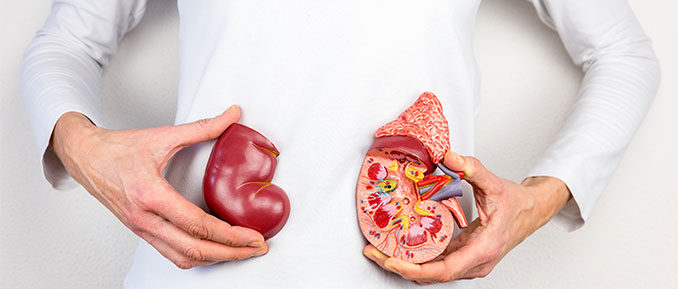
As the world’s population ages, the demand for organs and ways to optimize the transplant process will only grow. While the exact interactions between different factors must be elucidated further, it is clear that allograft rejection is partially mediated by epigenetic mechanisms such as histone acetylation, DNA methylation, and microRNAs. This framework is useful when applied to the host and the graft as well as to the immunologic and nonimmunologic reasons for rejection. At this time individualized treatment is limited by objective measures of organ quality and postoperative organ function, largely due to the fact that biopsies are inadequate indicators (Moreso, 2013; McCaughan 2012). One of the barriers to improving outcomes is learning how to modulate the molecular “dialogue” between graft and host.
Uncovering new biomarkers is one immediate application for epigenetics in the transplant process. Elevated promoter hypermethylation was observed in the transplant group compared to the control, which may not be particularly helpful, but the same group found the CALCA promoter was highly methylated in patients with acute tubular necrosis compared to those with acute rejection or normal graft function (Mehta, 2006). Thiopurine methyltransferase genotyping can be used in clinical practice to assess the risk of myelosuppression with azathioprine treatment. Thiopurine methyltransferase genotyping has been suggested as a way of assessing the risk of the immunosuppressant azathioprine (Anglicheau, 2004). This is only a baby step towards putting together “detailed interrogations of the transplant recipients,” but it is a start.
Viral infection is another postoperative concern; Epstein-Barr being the major contributor to post-transplant lymphoproliferative disorder. Cytomegalovirus infections also cause a significant number of deaths after transplantation. It has been shown that CMV gene expression in infected cells can be silenced. In murine cell models, histone modification can encourage the transition from acute to latent CMV infection (Hsu, 2012; Liu, 2013). T-cell activation occurs through the production of interleukin-2, which is upregulated through DNA methylation and chromatin remodeling. Histone deacetylation is also a player here, prolonging graft survival in animal models of heart and kidney transplants. RNA interference blocks the “costimulatory” signal between dendritic and T-cells, which mitigates T-cell response to alloantigens. As McCaughan et al. note, “the nonspecific nature of epigenetic treatments could be overcome by harnessing RNA interference.”
An allograft undergoes rapid changes after it is introduced to the host – and before. Reperfusion of the graft inflicts oxidative damage upon DNA, proteins, lipids, and plasma membranes – it can also alter its epigenome for the worse. As well, cold storage has multiple drawbacks that restrict the duration of preservation and the number of organs that can be safely used for transplant (Hosgood, 2015). Myocardial hypoxia activates HDACs, but treatment with HDAC inhibitors can reduce the area of ischemic injury. Acute renal injury results in H3 activation in mice, leading to inflammation and fibrosis (Granger, 2008).
Hurtado et. al.’s paper recently reviewed a means for monitoring kidney development with the assistance of lab grown organoids derived from pluripotent stem cells and CRISPR to explore the cause and effect relationships of epigenetic modifications in the kidney. This research has “successfully recapitulated not only kidney differentiation, but also the specific phenotypical traits related to kidney function.” Rapidly producing and analyzing different combinations of traits using these models could allow further insights to be gleaned into what is still a poorly understood area of research.
Epigenetic analyses and therapies are being developed to improve the transplant process. The prospects of applications in the near future look promising. The dialogue between the graft and host, which is critical to establishing and maintaining tissue compatibility, is largely composed of epigenetic phenomena.
Works Cited
Granger, Anne, et al. “Histone deacetylase inhibition reduces myocardial ischemia-reperfusion injury in mice.” The FASEB Journal 22.10 (2008): 3549-3560.
Moreso F, Hernández D. Has the Survival of the Graft improved After Renal Transplantation in the Era of Modern Immunosuppression? Nefrologia. 2013; 33: 14–26.
McCaughan JA, McKnight AJ, Courtney AE, et al. Epigenetics: Time to Translate into Transplantation. Transplantation. 2012; 94: 1–7.
Mehta TK, Hoque MO, Ugarte R, et al. Quantitative Detection of Promoter Hypermethylation as a Biomarker of Acute Kidney Injury During Transplantation. Transplant Proc. 2006; 38: 3420–3426.
Anglicheau D, Legendre C, Thervet E. Pharmacogenetics in Solid Organ Transplantation: Present Knowledge and Future Perspectives. Transplantation 2004; 78: 311.
Hsu CC, Li HP, Hung YH, et al. Targeted Methylation of CMV and E1A Viral promoters. Biochem Biophys Res Commun 2010; 402: 228.
Liu, Xue-feng, et al. Epigenetic Control of Cytomegalovirus Latency and Reactivation. Viruses 5.5 (2013): 1325-1345.
Hosgood, Sarah A., Ernest van Heurn, and Michael L. Nicholson. Normothermic Machine Perfusion of the Kidney: Better Conditioning and Repair?. Transplant International 28.6 (2015): 657-664.
Hurtado et. al. Modeling Epigenetic Modifications in Renal Development and Disease with Organoids and Genome Editing Disease Models & Mechanisms 2018 Nov 1; 11(11).

